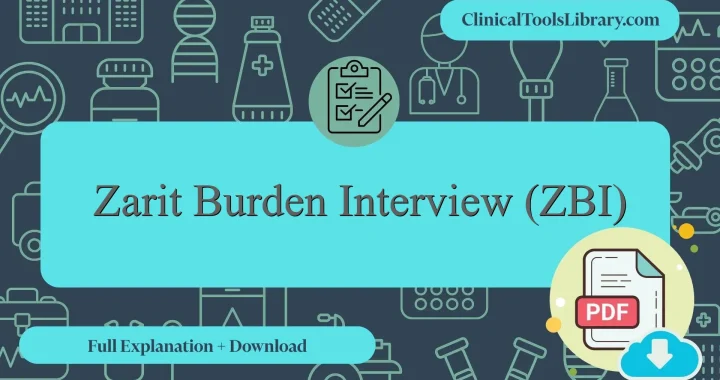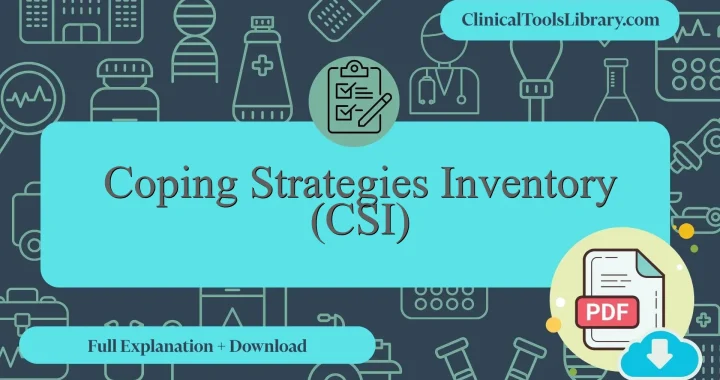In this article, we explain everything you need to know about the Zarit Burden Interview (ZBI). We will cover the aspects it evaluates, the target population, a detailed step-by-step explanation, and how to interpret its results. Additionally, we will dive into the scientific evidence supporting this tool (diagnostic sensitivity and specificity) in clinical assessment. You will also find official and unofficial sources available for download in PDF format.
What does the Zarit Burden Interview (ZBI) assess?
The Zarit Burden Interview (ZBI) is a widely utilized tool designed to assess the level of perceived burden experienced by caregivers of individuals with chronic illnesses or disabilities. Its main purpose is to quantify the impact of caregiving in terms of emotional, physical, and social stress, facilitating the identification of caregivers at risk of adverse health outcomes. The instrument is available in various formats, including the Zarit Burden Interview short form and the full Zarit Burden Interview 22 items PDF, ensuring adaptability to different clinical and research settings. Additionally, brief versions such as the zarit burden interview 4-item screening questionnaire and zarit burden interview 6-item provide rapid appraisal options. Scoring methods, such as the Zarit Burden Interview 12 scoring, allow for standardized Zarit Burden Interview score interpretation, enabling clinicians to monitor caregiver strain effectively. Usage of the tool requires adherence to Zarit Burden Interview permission protocols to ensure ethical administration and data handling.
For which type of patients or populations is the Zarit Burden Interview (ZBI) intended?
The Zarit Burden Interview is primarily indicated for caregivers of patients with chronic and progressive conditions such as Alzheimer’s disease, Parkinson’s disease, and other forms of dementia. It is most useful in clinical contexts that require the assessment of caregiver stress and burden to guide supportive interventions and resource allocation. Variants like the Zarit Burden Interview short form and the zarit burden interview 4-item screening questionnaire facilitate rapid evaluation in outpatient or community settings. The instrument’s validated scoring systems, including the Zarit Burden Interview 12 scoring method, allow clinicians to quantify the impact of caregiving, informing clinical decision-making and caregiver support planning. Proper interpretation of Zarit Burden Interview score results provides valuable insights into the psychological and functional challenges faced by caregivers, particularly in neurodegenerative and chronic illness contexts.
Step-by-Step Explanation of the Zarit Burden Interview (ZBI)
The Zarit Burden Interview (ZBI) consists of 22 items designed to assess the perceived burden experienced by caregivers of individuals with chronic illnesses such as Alzheimer’s disease and other dementias. The questions focus on various dimensions including emotional, social, and financial impacts of caregiving. Respondents rate each item using a 5-point Likert scale ranging from 0 (never) to 4 (nearly always), reflecting the frequency with which specific caregiving difficulties are experienced. To administer the ZBI, the clinician or researcher reads each standardized question aloud or provides a written form, ensuring the caregiver understands every item before responding. Scores are summed to yield a total burden score, with higher values indicating greater caregiver distress, facilitating targeted support planning and intervention.
Downloadable Zarit Burden Interview 22 Items PDF in Original and English for Assessment
Below are downloadable resources in both the original language and English versions of the Zarit Burden Interview 22 items PDF. These materials facilitate accurate assessment of caregiver stress and burden associated with chronic conditions, ensuring standardized evaluation across diverse populations. Healthcare professionals may utilize the documents for clinical and research purposes, adhering to the appropriate Zarit Burden Interview permission protocols to maintain ethical standards.
How to interpret the results of the Zarit Burden Interview (ZBI)?
The Zarit Burden Interview (ZBI) quantifies caregiver burden by summing scores from 22 items, each rated on a 5-point scale (0 to 4), yielding a total score ranging from 0 to 88. Interpretation follows established reference ranges: scores under 21 indicate little or no burden; 21-40 suggest mild to moderate burden; 41-60 reflect moderate to severe burden; and above 60 denote severe burden. The formula for the total score is Total ZBI Score = Σ (Item Scores 1 to 22). In clinical practice, elevated scores may signal the need for targeted interventions to alleviate caregiver stress, particularly in managing patients with chronic conditions such as Alzheimer’s disease or Parkinson’s disease. Healthcare professionals should incorporate ZBI results into comprehensive care plans, recognizing that higher burden scores correlate with increased risk of caregiver burnout and diminished quality of life, warranting appropriate psychosocial support.
What scientific evidence supports the Zarit Burden Interview (ZBI) ?
The Zarit Burden Interview (ZBI), originally developed in 1980 by Zarit et al., is a widely validated instrument designed to assess the burden experienced by caregivers of individuals with chronic illnesses such as Alzheimer’s disease and other forms of dementia. Numerous studies have confirmed the test’s reliability and construct validity, demonstrating strong internal consistency with Cronbach’s alpha coefficients typically exceeding 0.85. Cross-cultural validations have further supported its applicability in diverse populations, with factor analyses consistently identifying core domains related to emotional, social, and physical strain. The ZBI’s sensitivity to changes in caregiver burden over time has also been established, reinforcing its utility in both clinical and research settings to monitor the effectiveness of supportive interventions for caregivers managing complex neurodegenerative conditions.
Diagnostic Accuracy: Sensitivity and Specificity of the Zarit Burden Interview (ZBI)
The Zarit Burden Interview (ZBI) demonstrates variable sensitivity and specificity depending on the cutoff points and populations studied. In clinical settings assessing caregiver burden related to dementia, the ZBI has shown sensitivity ranges from approximately 70% to 85%, indicating its effectiveness in correctly identifying caregivers experiencing significant burden. Specificity values typically range from 60% to 80%, reflecting its ability to exclude those without substantial burden. These metrics may fluctuate with different versions of the instrument and cultural adaptations, necessitating careful interpretation in diverse cohorts. Overall, the ZBI remains a validated tool with acceptable psychometric properties for screening caregiver strain among patients with neurodegenerative disorders.
Related Scales or Questionnaires
Several assessment tools share similarities with the Zarit Burden Interview (ZBI), including the Caregiver Strain Index (CSI), the Burden Assessment Scale (BAS), and the Caregiver Reaction Assessment (CRA). The CSI is brief and easy to administer, making it suitable for quick screenings, but it may lack the depth of the ZBI. The BAS provides a broader evaluation of psychosocial stress but requires more time to complete, which can limit its use in fast-paced clinical settings. The CRA assesses both positive and negative caregiving aspects, offering a more balanced perspective, yet its complexity might pose challenges for some respondents. The Zarit Burden Interview short form, such as the 4-item and 6-item versions, offers efficient alternatives with validated scoring methods like the Zarit Burden Interview 12 scoring, facilitating quicker assessments without substantially compromising reliability. Each of these scales and questionnaires is thoroughly explained and available for download on ClinicalToolsLibrary.com, providing valuable resources for healthcare professionals managing caregiver burden in diverse conditions such as dementia and stroke.
https://www.youtube.com/watch?v=wmTgeZ1EWxU




